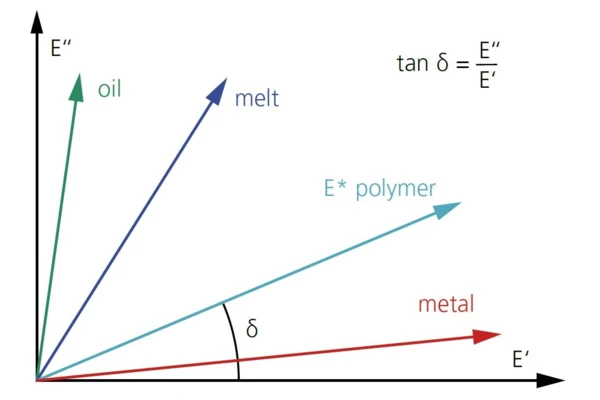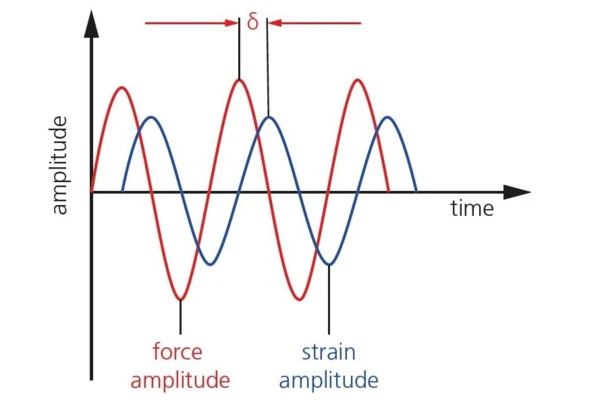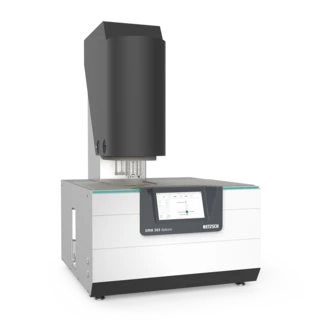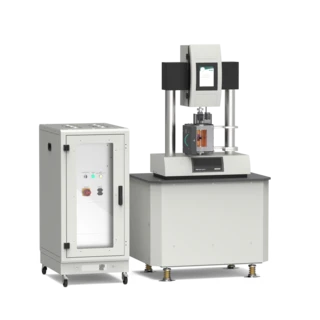Highlights
The DMA GABO Eplexor® HT line is the only instrument series on the market which is able to carry out DMA measurements with a maximum dynamic force of 500 N to 1500°C.
Two high-temperature furnaces are available: RT to 1000°C and RT to 1500°C. With a standard furnace (-160°C to 500°C) simultaneously mounted, it is possible to perform consecutive test runs in both the low- and high-temperature range. Eplexor® HT instruments can thus cover the entire temperature span from -160°C to 1500°C.
The electronics within the system automatically identify which furnace is currently in use.
The following DMA GABO Eplexor® HT are available:
| Instrument Type | Max. Static Force | Max. Dynamic Force *) |
|---|---|---|
| DMA GABO Eplexor® 25N HT | 1500 N | ± 25 N |
| DMA GABO Eplexor® 100N HT | 1500 N | ± 100 N |
| DMA GABO Eplexor® 150N HT | 1500 N | ± 150 N |
| DMA GABO Eplexor® 500N HT | 1500 N | ± 500 N |
Method
The Dynamic Mechanical Thermal Analyzer applies forced periodic loads to the sample and analyzes the phase shift between this primary excitation and the material’s response. The response of an ideal elastic system (e.g., spring) on a sinusoidal load at a given frequency is of the same frequency and exactly in phase with the excitation. The situation changes in a real system: A phase shift (δ > 0°) between the primary excitation and response of the same frequency occurs in the case of linear visco-elastic materials (e.g., polymers).


Elastic and non-elastic properties inherently describe the dynamic mechanical performance of the material. The storage modulus E’, the real part of the Complex ModulusThe complex modulus consists of two components, the storage and the loss moduli. The storage modulus (or Young’s modulus) describes the stiffness and the loss modulus describes the damping (or viscoelastic) behavior of the corresponding sample using the method of Dynamic Mechanical Analysis (DMA). complex modulus E*, represents the elastic component; the Viscous modulusThe complex modulus (viscous component), loss modulus, or G’’, is the “imaginary” part of the samples the overall complex modulus. This viscous component indicates the liquid like, or out of phase, response of the sample being measurement. loss modulus E’’, the dissipated part, is the imaginary part. Depicted in the complex plane, the loss and storage modulus are the projections of the Complex ModulusThe complex modulus consists of two components, the storage and the loss moduli. The storage modulus (or Young’s modulus) describes the stiffness and the loss modulus describes the damping (or viscoelastic) behavior of the corresponding sample using the method of Dynamic Mechanical Analysis (DMA). complex modulus onto the real and imaginary axis. The tangent of the angle between the real axis and the Complex ModulusThe complex modulus consists of two components, the storage and the loss moduli. The storage modulus (or Young’s modulus) describes the stiffness and the loss modulus describes the damping (or viscoelastic) behavior of the corresponding sample using the method of Dynamic Mechanical Analysis (DMA). complex modulus (E*) represents the phase shift (tanδ) between the two.
Specifications
Technical Data
Temperature Range
the full temperature range can be covered if the instrument is equipped with the low-temperature and one high-temperature furnace
Frequency Range
optional: 0.0001 Hz; 200 Hz
Static Force Range
- Dynamic force range:
from ± 25 N up to ± 500 N (depending on instrument type, see table) - Force sensor:
interchangeable; nominal forces available from 10 N to 500 N (depending on the instrument type and configuration) - Static displacement:
max. 60 mm - Dynamic amplitude:
from ± 1.5 mm up to ± 6 mm (depending on the instrument type and system configuration) - Measurement modes for applications above 500°C:
asymmetric and 3/4-point bending, compression - Work space of the high-temperature furnaces:
cylindrical chamber, diameter: 70 mm, height: 120 mm
Software
The comprehensive DMA GABO Eplexor® HT Series software is based on Windows operating systems. The extensive software package comprises data and curve analyses, hysteresis representation, master curve calculations, etc.
It also includes specific templates for tension, compression or bending tests.
The software features include:
- Frequency sweep of 0.001 Hz to 100 Hz (optional 0.0001 Hz and 200 Hz)
- Temperature sweep (controlled temperature variation at fixed frequency)
- Time sweep from 1 s to 107 s
- Correlated temperature and frequency sweep at IsothermalTests at controlled and constant temperature are called isothermal.isothermal steps
- Correlated dynamic and static StrainStrain describes a deformation of a material, which is loaded mechanically by an external force or stress. Rubber compounds show creep properties, if a static load is applied.strain amplitude sweeps; equidistantly or logarithmically subdivided
- Master curves (TTS, WLF, numeric mastering), segment tests
- Evaluation of Complex ModulusThe complex modulus consists of two components, the storage and the loss moduli. The storage modulus (or Young’s modulus) describes the stiffness and the loss modulus describes the damping (or viscoelastic) behavior of the corresponding sample using the method of Dynamic Mechanical Analysis (DMA). complex modulus (E*, G*), storage modulus (E’, G’), Viscous modulusThe complex modulus (viscous component), loss modulus, or G’’, is the “imaginary” part of the samples the overall complex modulus. This viscous component indicates the liquid like, or out of phase, response of the sample being measurement. loss modulus (E’’, G’’) damping factor (t and δ) by temperature sweeps, StrainStrain describes a deformation of a material, which is loaded mechanically by an external force or stress. Rubber compounds show creep properties, if a static load is applied.strain and force sweeps, time sweeps, Glass Transition TemperatureThe glass transition is one of the most important properties of amorphous and semi-crystalline materials, e.g., inorganic glasses, amorphous metals, polymers, pharmaceuticals and food ingredients, etc., and describes the temperature region where the mechanical properties of the materials change from hard and brittle to more soft, deformable or rubbery.glass transition temperature, and optional CreepCreep describes a time and temperature dependent plastic deformation under a constant force. When a constant force is applied to a rubber compound, the initial deformation obtained due to the application of the force is not fixed. The deformation will increase with time.creep, RelaxationWhen a constant strain is applied to a rubber compound, the force necessary to maintain that strain is not constant but decreases with time; this behavior is known as stress relaxation. The process responsible for stress relaxation can be physical or chemical, and under normal conditions, both will occur at the same time. relaxation, fatigue, energy loss, hysteresis, Payne/Mullins effect analysis and crack growth testing
- Determination of the thermal expansion in tension mode (optional)
- Prediction of the Rolling ResistanceThe rolling resistance is a force resisting the motion when a body is rolling across a surface. This determines the slip resistance of, e.g., car or truck tires.rolling resistance of tires (optional)

Consultancy & Sales
Do you have further questions about the device, the method and would you like to speak to a sales representative?
Service & Support
Do you already have an device and need technical support or spare parts?
Downloads & Media
Brochure
Application Literature
Related Devices
- DMA 303 Eplexor®

- Wide Temperature Range from -170°C to 800°C
- Precise Forces up to 50 N Dynamic and Static
- Accessories for Multiple Measuring Modes and a Variety of Sample Holders
- DMA 523 Eplexor®

- Static and dynamic force levels from max. ± 2000 N to max. ± 4000 N
- Sample Holders for a Variety of Applications
- Unrivaled Temperature Range from -160°C to 500°C
- DMA Eplexor® up to 500 N

- Two Independent Drives for Static and Dynamic Force
- Variety of Sample Holders for Handling the Tasks of Today and Tomorrow
- HBU 523 Gabometer

- Temperature Range up to 300°C
- Static force up to 6000N
- Static deformation up to 70 mm

